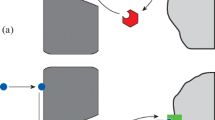Abstract
Insect olfactory receptor neurons are compartmentalized in sensilla. In a sensillum, typically two receptor neurons are in close contact and can influence each other through electrical interaction during stimulation. This interaction is passive, non-synaptic and a consequence of the electrical structure of the sensillum. It is analysed in a sensillum model and its effects on the neuron receptor potentials are investigated. The neurons in a sensillum can be both sensitive to a given odorant compound with the same sensory threshold or with different thresholds, or only one neuron be sensitive to the odorant. These three types of sensilla are compared with respect to maximum amplitude, threshold and dynamic range of the potentials. It is found that gathering neurons in the same sensillum is disadvantageous if they are identical, but can be advantageous if their thresholds differ. Application of these results to actual recordings from pheromone and food-odour olfactory sensilla is discussed.








Similar content being viewed by others
References
Altner H, Prillinger L (1980) Ultrastructure of invertebrate chemo-, thermo-, and hygroreceptors and its functional significance. Int Rev Cytol 67:69–139
Boeckh J, Ernst KD, Selsam P (1987) Neurophysiology and neuroanatomy of the olfactory pathway in the cockroach. In: Roper SD, Atema J (eds) Olfaction and taste IX. New York Academy of Sciences, New York, pp 39–43
Buck LB (1996) Information coding in the vertebrate olfactory system. Annu Rev Neurosci 19:517–544
de Bruyne M, Clyne PJ, Carlson JR (1999) Odor coding in a model olfactory organ: the Drosophila maxillary palp. J Neurosci 19:4520–4532
de Bruyne M, Foster K, Carlson JR (2001) Odor coding in the Drosophila antenna. Neuron 30:537–552
Fadamiro HY, Cosse AA, Baker TC (1999) Fine-scale resolution of closely spaced pheromone and antagonist filaments by flying male Helicoverpa zea. J Comp Physiol A 185:131–141
Hildebrand JG, Shepherd GM (1997) Mechanisms of olfactory discrimination: converging evidence for common principles across phyla. Annu Rev Neurosci 20:595–631
Kaissling K-E (1987) In Colbow K (ed) RH Wright lectures on insect olfaction. Simon Fraser University, Burnaby, BC, Canada
Kaissling K-E (1995) Single unit and electroantennogram recordings in insect olfactory organs. In: Spielman AI, Brand JG (eds) Experimental cell biology of taste and olfaction, current techniques and protocols. CRC Press, Boca Raton, pp 361–377
Kaissling K-E (2001) Olfactory perireceptor and receptor events in moths: a kinetic model. Chem Senses 26:125–150
Kaissling K-E, Thorson J (1980) Insect olfactory sensilla: structural, chemical and electrical aspects of the functional organization. In: Satelle DB, Hall LM, Hildebrand JG (eds) Receptors for neurotransmitters, hormones and pheromones in insects. Elsevier, Amsterdam, pp 261–282
Keil TA (1999) Morphology and development of the peripheral olfactory organs. In: Hansson B (ed) Insect olfaction. Springer, Berlin Heidelberg New York, pp 5–47
Krieger J, Breer H (1999) Olfactory reception in invertebrates. Science 286:720–723
Meunier N, Marion-Poll F, Rospars JP, Tanimura T (2003) Coding of bitter taste in Drosophila. J Neurobiol 56:139–152
Rospars J-P (1988) Structure and development of the insect antennodeutocerebral system. Int J Insect Morphol Embryol 17:243–294
Rospars J-P, Lansky P, Tuckwell H, Vermeulen A (1996) Coding of odor intensity in a steady-state deterministic model of an olfactory receptor neuron. J Comput Neurosci 3:51–72
Rospars J-P, Lansky P, Duchamp-Viret P, Duchamp A (2003) Relation between stimulus and response in frog olfactory receptor neurons in vivo. Eur J Neurosci 18:1135–1154
Schneider D, Kaissling KE (1957) Der Bau der Antenne des Seidenspinners Bombyx mori L. II. Sensillen, cuticulare Bildungen und innerer Bau. Zool Jahrb Abt Anat Ontog Tiere 76:223–250
Selzer R (1984) On the specificities of antennal olfactory receptor cells of Periplaneta americana. Chem Senses 8:375–395
Steinbrecht RA (1970) Zur Morphometrie der Antenne des Seidenspinners, Bombyx mori L.: Zahl und Verteilung des Riechsensillen (Insecta, Lepidoptera). Z Morphol Tiere 68:93–126
Steinbrecht RA (1996) Structure and function of insect olfactory sensilla. In: Bock GR, Cardew G (eds) Olfaction in mosquito-host interactions. Wiley, Chichester, pp 158–177
Steinbrecht RA (1997) Pore structures in insect olfactory sensilla: a review of data and concept. Int J Insect Morphol Embryol 26:229–245
Thurm U (1974) Basics of the generation of receptor potentials in epidermal mechanoreceptors of insects. In: Schwartzkopff J (ed) Symposium on mechanoreception. Rheinisch-Westfälische Akademie der Wissenschaften, Abhandlung Band 53. Westdeutscher Verlag, pp 355–385
Todd JL, Baker TC (1999) Function of peripheral olfactory organs. In: Hansson B (ed) Insect olfaction. Springer, Berlin Heidelberg New York, pp 67–96
Vermeulen A, Rospars J-P (1998a) Dendritic integration in olfactory sensory neurons: a steady-state analysis of how the neuron structure and neuron environment influence the coding of odor intensity. J Comput Neurosci 5:243–266
Vermeulen A, Rospars J-P (1998b) A simple analytical method for determining the steady-state potential in models of geometrically complex neurons. J Neurosci Methods 82:123–133
Vermeulen A, Rospars J-P (2001a) Membrane potential and its electrode-recorded counterpart in an electrical model of an olfactory sensillum. Eur Biophys J 29:587–596
Vermeulen A, Rospars J-P (2001b) Electrical circuitry of an insect olfactory sensillum. Neurocomputing 32–40:1011–1017
Zack C (1979) Sensory adaptation in the sex pheromone receptor cells of saturniid moths. Doctoral thesis, LMU München, pp 1–99
Acknowledgements
We thank Prof. Karl-Ernst Kaissling, Prof. Frédéric Marion-Poll and Dr Philippe Lucas for useful comments on a previous version of this manuscript.
Author information
Authors and Affiliations
Corresponding author
Rights and permissions
About this article
Cite this article
Vermeulen, A., Rospars, JP. Why are insect olfactory receptor neurons grouped into sensilla? The teachings of a model investigating the effects of the electrical interaction between neurons on the transepithelial potential and the neuronal transmembrane potential. Eur Biophys J 33, 633–643 (2004). https://doi.org/10.1007/s00249-004-0405-4
Received:
Revised:
Accepted:
Published:
Issue Date:
DOI: https://doi.org/10.1007/s00249-004-0405-4




